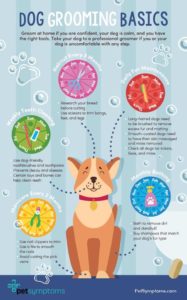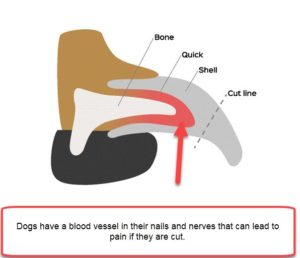This is a basic grooming guide by Rochelle Morris, owner of Herbie’s Hounds.
BASIC GROOMING
The most important thing to remember is that you want your dog to enjoy – or at least not hate – the grooming process.
Start slowly, with one thing at a time, and for the part(s) your dog hates the most, I suggest you give your dogs their favourite treats or a food that really gets their juices going!!
As I know only too well, some my lovely pooches I groom really enjoy the grooming process, some tolerate it, & the others really just don’t enjoy part or practically all of the grooming process, so if you are trying to groom at home, then break things up into smaller pieces and do everything over several days.
For example, on day one, trim the nails, brush their coats, and maybe cut a little around their ‘potty’ areas!
The next day, perhaps give them a bath, & a blow dry, if they tolerate a hairdryer. If not, use a microfibre towel (if possible), to “wring out” the excess water, & keep them wrapped up in a towel whilst they are drying. PLEASE NOTE: For curly or wool coated dogs (in particular), please be mindful these breeds get matted more easily, & as soon as water ‘hits’ their coat it will start to tighten, so you need to brush & dry at the same time. Alternatively, use a non-rinse dry shampoo.
If you are going to cut your dog’s coat, then I suggest you try the “following day”, & PLEASE only use professional dog clippers, (not nasty cheap ones you can buy from places like Argos, or on line). Otherwise, use a rounded blunt scissor, & hold the scissor at an angle, (particularly around the eyes/face areas).
The clippers I use are very expensive dog grooming clippers, & the blade numbering correlates to these clippers only.
However, I am “not” encouraging anyone to use clippers on their dogs, as you really do need to know what blades to use & how to hold the clippers, & you do not want to give your dog ‘clipper burns’ or ‘tram lines’!!
Breaking the grooming process up into several different sessions will help, but PLEASE only do what you feel comfortable in doing.
NAILS
Nail trimming is one part of grooming that every dog need!!
Long nails can cause problems walking, arthritis, and the nail can even curve into the pad of the dog’s foot. Imagine how uncomfortable it must be to have something poking your foot ALL the time and how painful each step must be!
In general, you should plan on trimming your dog’s nails on each groom, but some dogs will need more- or less-frequent nail trimming.
For example, large dogs that walk on pavements or asphalt more than an hour every day, often wear down their nails and need little trimming apart from their dew claws (that’s the little claw halfway up the side of the paw). Small dogs tend to go for shorter walks, or are not as heavy, so will need nail trimming more often.
As you may already know, dogs have a vein in their nails called a “quick” that will bleed if you cut it too short.
In dogs that don’t get their nails cut frequently enough, the vein can grow very long, so you can only take a little bit off at a time. If that’s the case, you should trim a little bit off your dog’s nails every week to encourage the vein to shrink back into the nail.
Use dog nail clippers & the easiest way to cut your dog’s nails is to position your dog in a way where you can flip their paw back and look at the underside and trim a little bit at a time.
In dogs with white nails, you can see the quick inside the nail and know where to cut. For black nails, cut off a little bit at a time. You will see a tiny black dot surrounded by white when you get close to the quick. That’s how you know to stop!
You can purchase styptic powder and keep it handy to stop bleeding if you trim a nail too short. In a pinch, you can use flour or corn starch to stop the bleeding, but don’t worry, it always look worse than it is!
BRUSHING
Every dog needs brushing! Yes, even your short-haired dog!
Most short-haired dogs shed at least a little bit. Using the right brush can remove loose hair and spread your dog’s natural oils through his coat for a healthy shine. A ‘curry brush’ is recommended for short haired dogs.
The brush I always highly recommend is a “slicker brush”, & long haired & again in particular, curly or wool coated dogs should be ideally brushed ‘every day’ to prevent matting!!
For dogs with double coats that should not be clipped, an ‘undercoat rake’ should be used to rake out the ‘dead hair’.
Straight haired dogs can also be brushed using a ‘pin brush’.
TEETH
Did you know that 80% of dogs have periodontal disease or other dental problems by the time they’re 3 years old?!
Gum disease is no small matter – it can lead to teeth falling out, abscesses, a broken jaw, heart disease, & the bacteria can get into their bloodstream and can be fatal. A horrible thought, but so important!!
You should aim to brush your dog’s teeth every day!!
If you’ve never brushed your dog’s teeth before, you need to start slowly. Let them sniff and lick the dog toothpaste first (NEVER use human toothpaste), then put the toothpaste on your finger and rub it on the outside of your dog’s teeth. Work your way up to a finger toothbrush and then a dog toothbrush.
For dogs that refuse to let you brush their teeth, there are dental sprays and tooth wipes that can help a little bit. It’s also a good idea to give your dog access to plenty of things to chew on, to help reduce plaque
EARS, EYES & PAWS
You should clean out your dog’s ears at least once a week.
You can use an ear cleaner/wipes made for dogs or non-perfumed baby wipes (water based).
In a round circular motion clean your dog’s ears as far as your finger will let you go, & remove any wax that has built up. Clean the ‘leather’ of the ear as well.
Dogs in general and flat-faced breeds, in particular, are prone to eye problems. At least once a week, you should take the time to look at your dog’s eyes. They should be bright and clear with no cloudiness and minimal redness.
Tears should be clear. If your dog has colored discharge coming from their eyes (different from the reddish-brown goop that can accumulate from normal tears), they need to go to the vet to check for an infection, injury, or allergies.
Many dog breeds have hair that grows in the corner of their eyes. This needs to be trimmed regularly to prevent it from growing long enough to irritate your dog’s eyes.
You can trim it using round-tipped eye/face scissors (similar to human nail scissors), & please cut an ANGLE. This area is extremely delicate, & you do not want to be poking your dogs eyes with the scissors!!!
Most dogs grow hair between the pads on the bottoms of their feet. When this hair gets long, it can collect mud, pesticides, pavement salt, and debris. With dogs that have continuously-growing hair, the hair can become matted and cause painful lumps.
You can use scissors (very carefully!) or trimmers to cut the hair flush with your dog’s paw pads. Don’t dig down between the paw pads because it’s very easy to nick your dog, & most dogs are extremely sensitive in this area, & it tickles!!!

